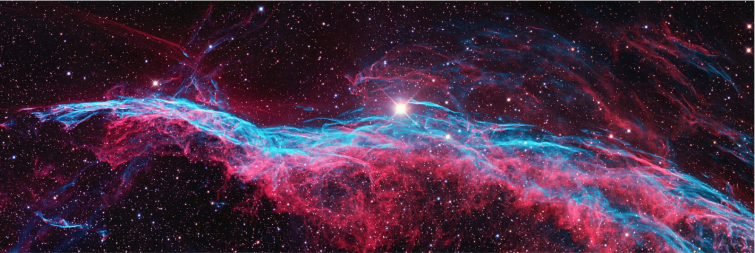The Veil Nebula

Search the sky for the Veil Nebula! It is a very interesting object, with a somewhat mysterious shape. Did you know there is a Western and Eastern Veil?
It was created after a supernova explosion from ejected gases from the star. These gases can condense and combine with interstellar hydrogen, which is excellent material for the formation of new stars.
But before that course of events, the ejected gas spreads smoothly through interstellar space and after a few thousand in the sky we get a nice remnant of the explosion, a cloud of rarefied gas. One such is our Veil nebula.
The Veil Nebula is located 1410 or 2100 light years away from us, it is not entirely clear because the sources of this data do not agree. In any case, this nebula is one of the closest remnants of a supernova.
The supernova that gave rise to the Veil exploded 10,000 years ago, and it was first observed on Earth by William Herschel, probably the most famous amateur astronomer of all time. In fact, Herschel observed only a part of the nebula, a cloud that was later named NGC 6960 and which apparently rests on the star 52 Cygnus.

That star does not belong to the nebula and is much closer to us (201 light years). In fact, that cloud is better known as the Western Veil. Since then, astronomers have carefully studied the entire area and cataloged the other scattered parts of Veil. So today we also know about the Eastern Veil, or NGC 6992, and there are also smaller parts: NGC 6995 with an extension of IC 1340.
Between the main arcs in the nebula are three concentrations of high-luminosity gas called the Pickering’s triangle. It was discovered by the assistant astronomer of Edward Charles Pickering. Her name was Williamina Fleming.
So, we have the Veil Nebula, which consists of two large clouds, the Eastern and Western Veil. This is important for astrophotographers who often photograph only part of the nebula, so it is desirable to know which part they have photographed.
Otherwise, this nebula can be used to evaluate the success of an astrophotographer because it requires a lot, not only knowledge, but also a developed sense of aesthetics.
Veil is beautiful to look at, but you need a solid amateur telescope and a clear, dark sky for it.

